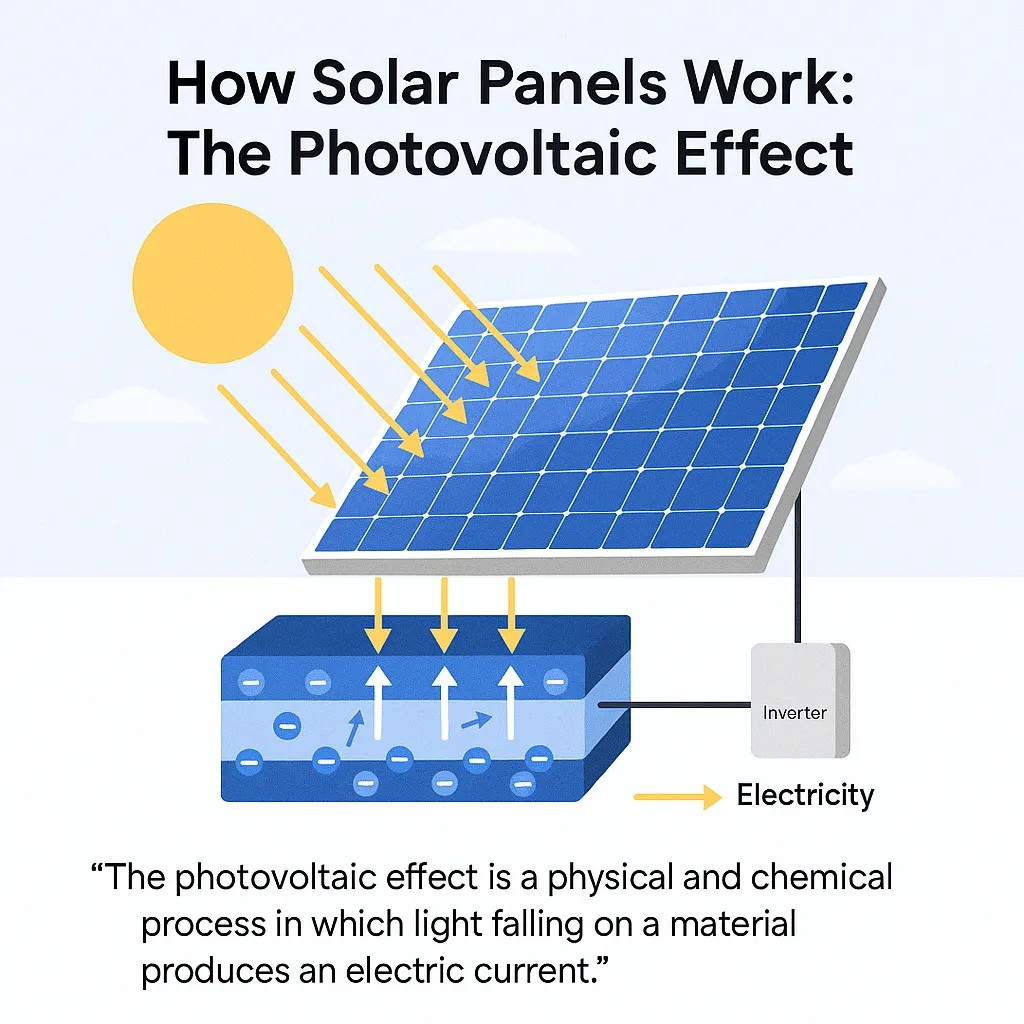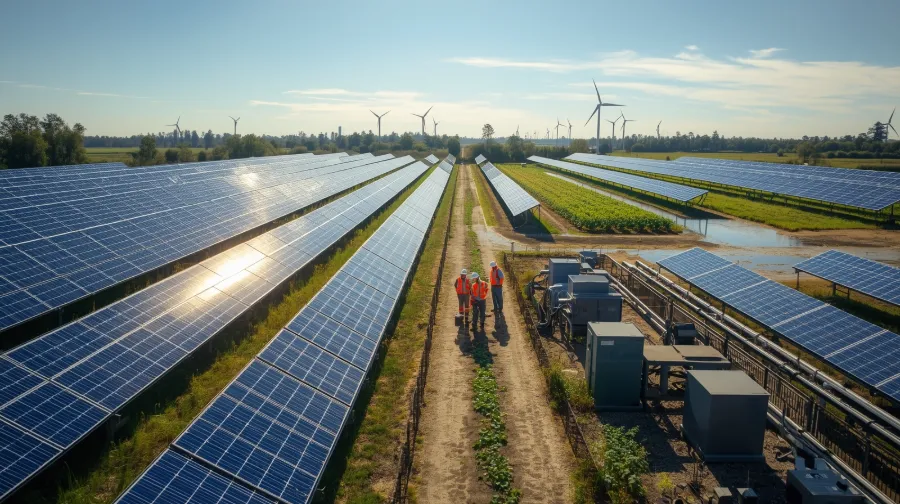Solar energy is obtained from sunlight. We use different technologies to turn it into electricity or heat. It is endless and also very important for reducing the use of old fuels.

It is important to know the basics of solar energy, so that we can understand its benefits and problems. This awareness helps us make better decisions about its use in the energy system.
Key Takeaways
- Solar energy is a renewable source of energy that is derived from sunlight.
- This can be used to generate heat or electricity to power everyday tasks.
- It is inexhaustible and plays a significant role in reducing the use of fossil fuels.
- It is important to gain basic knowledge to better understand its advantages and disadvantages.
- Its contribution to the move towards clean energy is considered particularly important.
What is Solar Energy? Definition and Basic Principles
Solar energy is derived from sunlight and plays a fundamental role in the move towards renewable energy.
The Scientific Definition of Solar Energy
Solar energy actually comes from the light and heat produced by the nuclear reactions of the sun. It comes out as electromagnetic radiation, like visible light and UV. Solar panels use this same light to generate electricity using photovoltaic methods.
The science world calls solar energy a renewable energy that is both sustainable and endless. It is important to understand how solar energy works so that it can be seen as a good clean energy choice.
Solar Energy as a Renewable Power Source
Solar energy is regarded as superior to non-renewable sources. It helps reduce carbon emissions and combat climate change. It is sustainable, widely accessible, and contributes to lower electricity usage.
| Benefits of Solar Energy | Description |
|---|---|
| Abundance | Solar energy is available everywhere, making it a universally accessible resource. |
| Sustainability | Solar energy is sustainable and non-depletable, which is a long-term energy solution. |
| Cost-Effectiveness | By harnessing solar energy, individuals and businesses can reduce their energy costs. |
The History and Evolution of Solar Technology
The story of solar energy is both attractive and long. It has been around for generations and has evolved from its beginnings to modern technology. The journey has been filled with important milestones.
Who Discovered Solar Energy?
Solar energy was discovered in the 19th century by Edmond Becquerel, a French scientist. He observed the photovoltaic effect in 1839. This discovery proved to be a major breakthrough towards solar cells.
Charles Fritts used selenium to create the first solar cell in history in 1883. This was a key moment in making solar energy practical.
The early 20th century saw more progress. Solar cells became more efficient. The first commercial solar panels were made.
Key Milestones in Solar Technology Development
The 1950s brought the first commercial solar panels. They had efficiencies of 4-6%. The development of solar technology and its application to satellite power were also influenced by the space age.
The 1970s oil crisis made people look for alternative energy. Solar power became more impressive. In recent years, technology has made solar panels better and cheaper.
How Solar Energy Works to Generate Electricity
Solar power generation is a fusion of technology and nature. It is a non-exhaustive, clean way to generate electricity from sunlight.
How Solar Panels Work: The Photovoltaic Effect
Solar panels use the photovoltaic (PV) method to convert sunlight into electricity.
When sunlight hits the panel, photons free electrons from the semiconductor material, creating an electric current. This current, which is usually DC, passes through an inverter and is converted to electricity for domestic or grid use.
“The photovoltaic effect is a physical and chemical process in which light falling on a material produces an electric current.”

From sunlight to usable electricity: The transformation process
There are a few easy steps involved in turning sunlight into electricity. First, solar panels catch sunlight and turn it into direct current (DC) electricity. This DC electricity is transformed into AC by the inverter so that homes and businesses can use it.
“One of the main factors that has made solar energy a dependable source of electricity is its capacity to be stored for later use.”
In short, solar energy uses sunlight through solar panels, which are converted into electricity through the photovoltaic process. It is then converted into usable energy, making solar energy a better and more environmentally friendly source.
Practical Applications and Limitations of Solar Energy
Solar energy is a renewable source of electricity. It is important to know its benefits and limitations.
Can Solar Panels Work at Night?
Solar panels need sunlight to work. But, new tech lets us store energy for night use. This means that electricity can remain available even in the dark.
Can Solar Energy Be Stored? Battery Solutions
Yes, we can store solar energy in batteries. Powerwall of Tesla is one example. It saves energy made during the day for later use.
The Environmental Impact: Are Solar Panels Recyclable?
The fact that solar panels can be reused is better for you. Materials like silicon, glass, and metal are used in them. New recycling tech is being developed to handle old panels.
| Material | Recyclability | Recycling Process |
|---|---|---|
| Silicon | Yes | Chemical etching and melting |
| Glass | Yes | Crushing and melting |
| Metal | Yes | Melting and reforming |
Where Are Solar Panels Made?
Solar panels are made all over the world. Countries like China, the US, and those in Europe are also playing an important role in this field. China is the largest producer, making up a large part of the global solar panel market. But, the US also has a big solar manufacturing industry, with many states having production facilities.
How much does a solar panel cost in the United States?
The quality of the panel, the installation company, and your location all affect how much solar panels cost in the US. It usually costs between $2.50 and $3.50 per watt.
The total cost for a typical home can be around $15,000 to $30,000 before savings.
How Much Do Solar Panels Cost?
By 2025, the cost of a home solar panel system (5 to 6 kW) worldwide is typically between US$10,000 and US$20,000. The cost per watt ranges from 0.08 to 0.12 euros in Europe, 0.20 to 0.40 dollars in the US, 40 to 60 rupees in India, and 27 to 40 rupees in Pakistan, depending on the brand and quality.
Due to net metering and cheap electricity costs, a 5 kW system in Pakistan can be installed for between Rs. 700,000 and Rs. 950,000 and pay for itself in three to five years.
For a home, how many solar panels are needed?
A home’s solar panel needs are determined by a number of variables. These include how much energy the home uses, the size of the roof, and how efficient the panels are. A typical home might need between 20 to 25 panels to meet its energy needs, assuming average energy use and standard panel efficiency.
Are Solar Panels Worth It?
Whether solar panels are beneficial or not depends on a few factors.
These include local electricity rates, available incentives, and how you plan to finance them. A return on investment analysis can help homeowners decide if solar panels are financially smart. Many find that solar panels cut their electricity bills and offer a long-term investment return.
Conclusion: The Future of Solar Energy
The future of solar energy looks bright, as its costs continue to fall and new technologies such as perovskite tandem cells and AI-based smart grids continue to improve its efficiency. It is estimated that by 2050 it will provide more than 30% of electricity of the world, especially in areas with around 300 days of sunshine a year.
Due to strong government policies and public interest, solar energy is set to become a mainstay of affordable, clean, and self-sufficient energy in the coming time.
I have personally seen many homes and businesses install solar systems, not only reducing their electricity bills but also adopting an environmentally friendly approach.
Posted by Abu Talha
With a background in science at the A-level, Abu Talha has studied subjects including physics, chemistry, mathematics, and biology. Along with his more than 1.5 years of experience in digital marketing, he is passionate about writing about electric vehicles, sustainable energy, and how emerging technologies are influencing the future.

